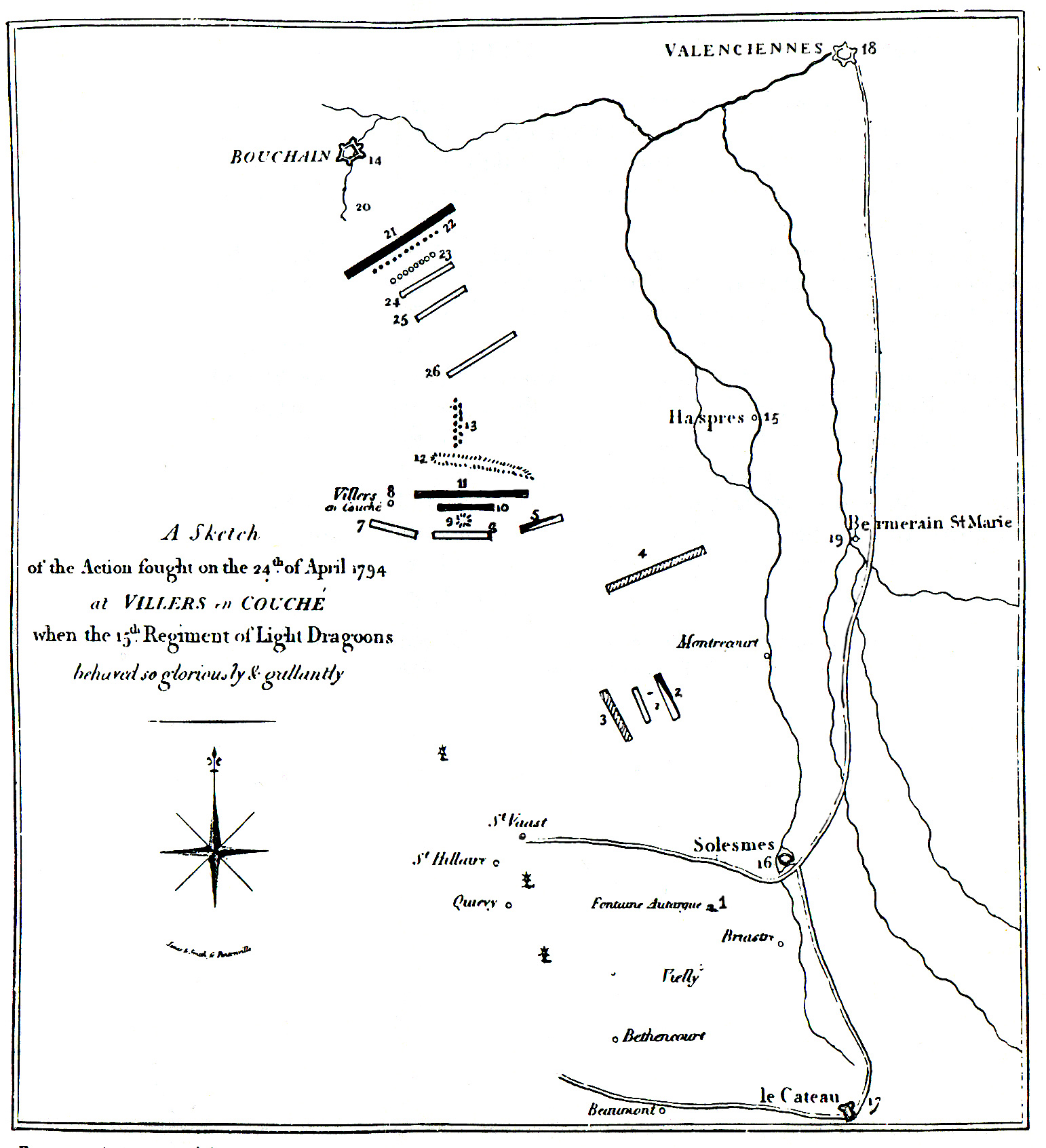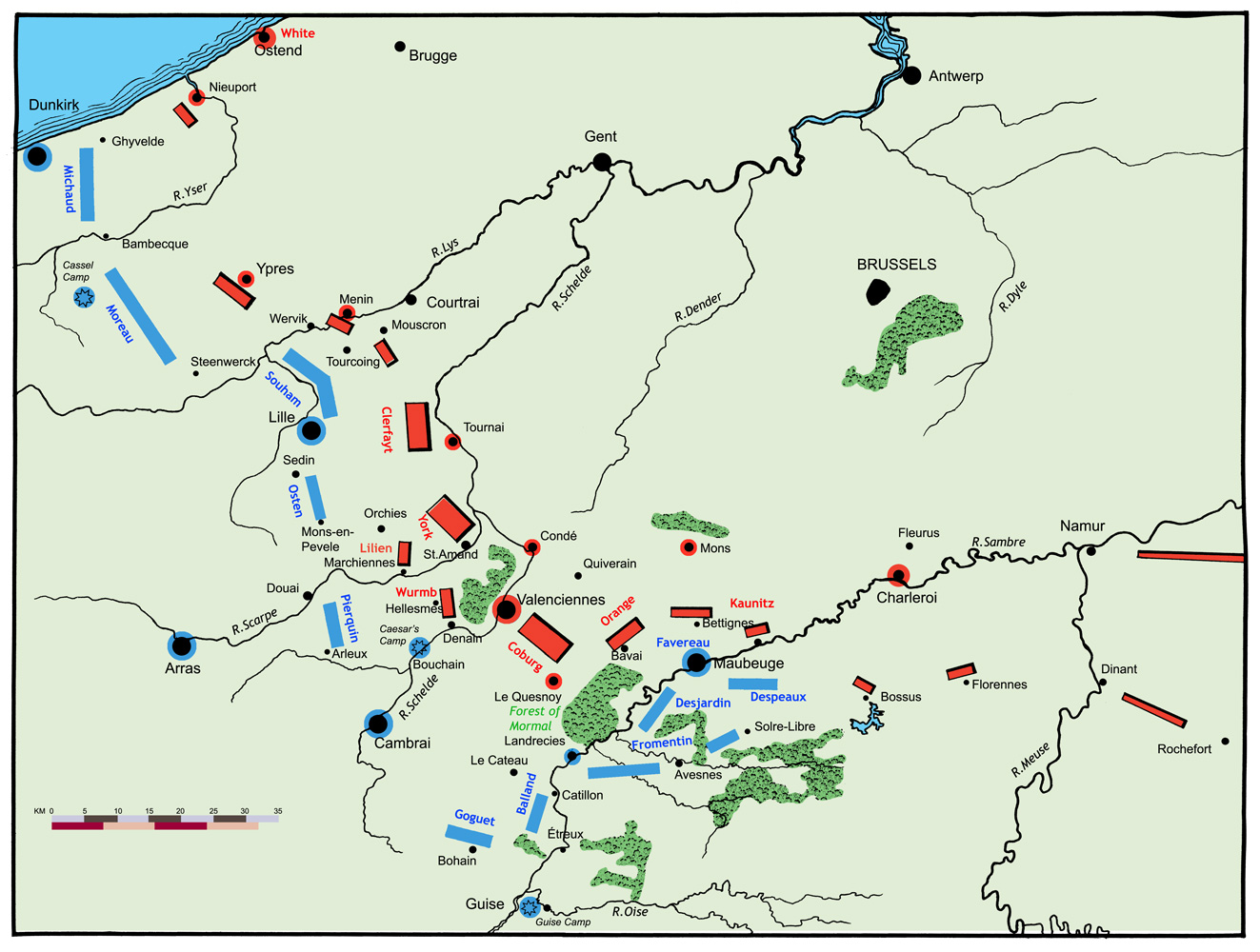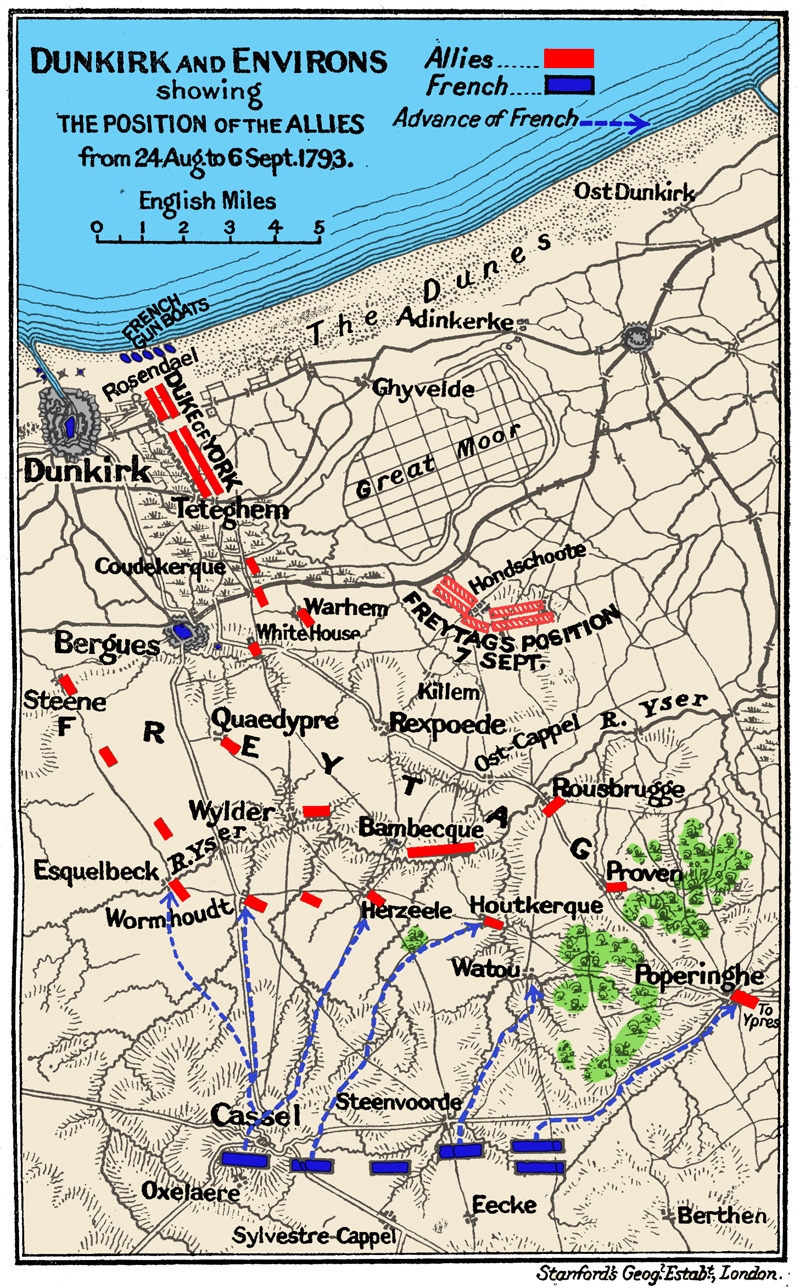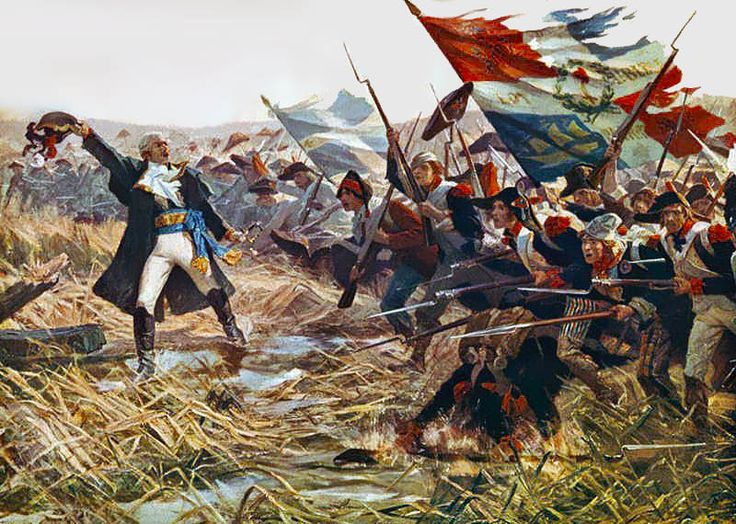|
15th (The King's) Hussars
The 15th The King's Hussars was a cavalry regiment in the British Army. First raised in 1759, it saw service over two centuries, including the First World War, before being amalgamated with the 19th Royal Hussars into the 15th/19th The King's Royal Hussars in 1922. History Early wars The regiment was raised in the London area by George Augustus Eliott, 1st Baron Heathfield as Elliots Light Horse as the first of the new regiments of light dragoons in 1759. It was renamed the 15th Regiment of (Light) Dragoons in 1760. The regiment landed in Bremen in June 1760 for service in the Seven Years' War. The regiment were largely responsible for the victory, suffering 125 of the 186 allied casualties at the Battle of Emsdorf in July 1760. Lieutenant Colonel William Erskine, commanding the regiment, presented King George III with 16 colours captured by his regiment after the battle. During the battle the French commander, Major-General Christian-Sigismund von Glaubitz, was taken prisone ... [...More Info...] [...Related Items...] OR: [Wikipedia] [Google] [Baidu] |
British Army
The British Army is the principal Army, land warfare force of the United Kingdom. the British Army comprises 73,847 regular full-time personnel, 4,127 Brigade of Gurkhas, Gurkhas, 25,742 Army Reserve (United Kingdom), volunteer reserve personnel and 4,697 "other personnel", for a total of 108,413. The British Army traces back to 1707 and the Acts of Union 1707, formation of the united Kingdom of Great Britain which joined the Kingdoms of Kingdom of England, England and Kingdom of Scotland, Scotland into a Political union, single state and, with that, united the English Army and the Scots Army as the British Army. The Parliament of England, English Bill of Rights 1689 and Convention of the Estates, Scottish Claim of Right Act 1689 require parliamentary consent for the Crown to maintain a peacetime standing army. Members of the British Army swear allegiance to the Charles III, monarch as their commander-in-chief. The army is administered by the Ministry of Defence (United Kingd ... [...More Info...] [...Related Items...] OR: [Wikipedia] [Google] [Baidu] |
Battle Of Emsdorf
The Battle of Emsdorf was fought on 16 July 1760 during the Seven Years' War at Emsdorf in present-day Hesse, Germany, between forces of British, Hanoverian and Hessian troops under the Prince of Hesse-Kassel (or Hesse-Cassel) against German troops in French service under ''Marechal de Camp'' von Glaubitz. It was part of the campaign to disrupt the French line of communications by capturing Marburg, a French supply depot. The Anglo-Hanoverian force consisted of six Hanoverian and Hessian infantry battalions, some Hanoverian jägers, Luckner's light cavalry hussars and the British 15th Light Dragoons. The French force consisted of five infantry battalions from the German regiments of Royal-Bavarière and Anhalt, a regiment of hussars and some light troops. The British forces initially surprised the French force in camp as they sat down to lunch. The French hussars fled at the onset while two of the infantry battalions managed to form up before receiving the concentrated fire ... [...More Info...] [...Related Items...] OR: [Wikipedia] [Google] [Baidu] |
Battle Of Tournay
A battle is an occurrence of combat in warfare between opposing military units of any number or size. A war usually consists of multiple battles. In general, a battle is a military engagement that is well defined in duration, area, and force commitment. An engagement with only limited commitment between the forces and without decisive results is sometimes called a skirmish. The word "battle" can also be used infrequently to refer to an entire operational campaign, although this usage greatly diverges from its conventional or customary meaning. Generally, the word "battle" is used for such campaigns if referring to a protracted combat encounter in which either one or both of the combatants had the same methods, resources, and strategic objectives throughout the encounter. Some prominent examples of this would be the Battle of the Atlantic, Battle of Britain, and the Battle of France, all in World War II. Wars and military campaigns are guided by military strategy, where ... [...More Info...] [...Related Items...] OR: [Wikipedia] [Google] [Baidu] |
Battle Of Willems
The Battle of Willems (10 May 1794) saw a First French Republic, Republican French army under Jean-Charles Pichegru oppose Coalition forces commanded by Prince Frederick, Duke of York and Albany, as part of a French attempt to defeat an Allied counteroffensive and continue its own 1794 offensive in the Low Countries, which had already seen success with the battle of Mouscron and the capture of the important cities of Menin and Courtrai. The battle was a French tactical defeat, but victory in the Battle of Courtrai (1794), battle of Courtrai the next day, coupled with the Duke of York's realisation that he was badly outnumbered, led to Allied withdrawal and a strategic victory for the French, who retained their hold on Menin and Courtrai. During this action, French infantry formed in squares and repulsed Coalition cavalry for the first time during the war. The fighting occurred during the War of the First Coalition near Kortrijk, Belgium, located about west of Brussels. Background ... [...More Info...] [...Related Items...] OR: [Wikipedia] [Google] [Baidu] |
Battle Of Villers-en-Cauchies
In the Battle of Villers-en-Cauchies, fought on 24 April 1794, a small Anglo-Austrian cavalry force routed a vastly more numerous French division during the Flanders Campaign of the French Revolutionary Wars. Villers-en-Cauchies is 15 km south of Valenciennes. Background At the beginning of the Flanders Campaign in 1794, the main Coalition army led by the Prince Josias of Saxe-Coburg-Saalfeld advanced against the French Army of the North under Charles Pichegru. By mid-April the Coalition began the Siege of Landrecies while the observation army took position in a broad semi-circle to cover the operation. On 23 April a French force was mustered in an attempt to cut off the Allied column of Ludwig von Wurmb from the rest of the observation army which consisted of the corps of François Sébastien de Croix de Clerfayt and Prince Frederick, Duke of York and Albany. Wurmb's command lay in a cordon of detachments between Denain and Hellesmes. All the available French tro ... [...More Info...] [...Related Items...] OR: [Wikipedia] [Google] [Baidu] |
Siege Of Landrecies (1794)
The siege of Landrecies (17–30 April 1794) was a military operation during the Spring 1794 campaign in the Low Countries theatre of the War of the First Coalition. It was conducted by the (mobile army) of the Dutch States Army, commanded by the Hereditary Prince of Orange, assisted by auxiliary forces from the Habsburg Austrian army, against the fortress of Landrecies, garrisoned by troops of the First French Republic under general Henri Victor Roulland. The fortress capitulated on 30 April 1794. Background In the amended that the military leaders of the Coalition agreed upon in The Hague in early April the capture of the fortress of Landrecies was a key objective. The mobile army of the States Army (which had not been active since the Battle of Menin (1793)) was charged with obtaining this objective. Landrecies had long been a contested city between France and the Habsburg Netherlands of which it originally a part. In 1543 the French conquered it and repulsed an attem ... [...More Info...] [...Related Items...] OR: [Wikipedia] [Google] [Baidu] |
Siege Of Dunkirk (1793)
The siege of Dunkirk took place in the Autumn of 1793 when British, Hanoverian, Austrian, and Hesse-Kassel troops under the command of Prince Frederick, Duke of York besieged the fortified French border port of Dunkirk, as part as the Flanders campaign of the French Revolutionary Wars. Following a Coalition defeat at the Battle of Hondshoote they were forced to raise the siege and withdraw northeast. Siege The decision to besiege Dunkirk was taken not by military commanders, but by the British government, chiefly by William Pitt's closest advisor, Secretary of State for War Henry Dundas. Dundas had considered the possession of Dunkirk as desirable, both as a bargaining chip in negotiations and as a potential British base in Europe. As a military objective towards winning the war, however, it was likely a mistake, as it prevented Prince Frederick, Duke of York from supporting the main Allied thrust further inland, and losing the strategic initiative. Nevertheless, York ... [...More Info...] [...Related Items...] OR: [Wikipedia] [Google] [Baidu] |
Siege Of Valenciennes (1793)
The siege of Valenciennes took place between 13 June and 28 July 1793, during the Flanders Campaign of the War of the First Coalition. The French garrison under Jean Henri Becays Ferrand was blockaded by part of the army of Prince Josias of Saxe-Coburg-Saalfeld, commanded by the Prince Frederick, Duke of York and Albany. Valenciennes fell on 28 July, resulting in an Allied victory. Background Following the defeat of the French Republican armies at Neerwinden, the Allied army under the Prince of Coburg recovered much of the Austrian Netherlands and began besieging Condé-sur-l'Escaut, while the demoralised French army's attempts to relieve the fortress in actions at Saint-Amand and Raismes were driven back. By mid-May Coburg was reinforced to a strength approaching 90,000, which allowed the Allies to drive the French from an entrenched camp in the Battle of Famars The Battle of Famars was fought on 23 May 1793 during the Flanders Campaign of the War of the First Coalition. ... [...More Info...] [...Related Items...] OR: [Wikipedia] [Google] [Baidu] |
Battle Of Famars
The Battle of Famars was fought on 23 May 1793 during the Flanders Campaign of the War of the First Coalition. An Allied Austrian, Hanoverian, and British army under Prince Josias of Saxe-Coburg-Saalfeld defeated the French Army of the North led by François Joseph Drouot de Lamarche. The battle occurred near the village of Famars in northern France, five km south of Valenciennes Valenciennes (, also , , ; ; or ; ) is a communes of France, commune in the Nord (French department), Nord Departments of France, department, Hauts-de-France, France. It lies on the Scheldt () river. Although the city and region experienced .... Background In May 1793, following a series of reverses the French Republican army in the Low Countries was in a desperate situation. Dispirited after the death of its former commander Augustin-Marie Picot de Dampierre, it was tired and disorganised. In addition it was further weakened by detachments taken from each battalion to serve in the war in ... [...More Info...] [...Related Items...] OR: [Wikipedia] [Google] [Baidu] |
Low Countries Theatre Of The War Of The First Coalition
The Low Countries theatre of the War of the First Coalition, also known as the Flanders campaign, was a series of campaigns in the Low Countries conducted from 20 April 1792 to 7 June 1795 during the first years of the War of the First Coalition. As the French Revolution radicalised, the revolutionary National Convention and its predecessors broke the Catholic Church's power (1790), abolished the monarchy (1792) and even executed the deposed king Louis XVI of France (1793), vying to spread the Revolution beyond the new French Republic's borders, by violent means if necessary. The First Coalition, an alliance of reactionary states representing the Ancien Régime in Central and Western Europe – Habsburg Austria (including the Southern Netherlands), Prussia, Great Britain, the Dutch Republic (the Northern Netherlands), Hanover and Hesse-Kassel – mobilised military forces along all the French frontiers, threatening to invade Revolutionary France and violently restore the m ... [...More Info...] [...Related Items...] OR: [Wikipedia] [Google] [Baidu] |
Ostend
Ostend ( ; ; ; ) is a coastal city and municipality in the province of West Flanders in the Flemish Region of Belgium. It comprises the boroughs of Mariakerke, Raversijde, Stene and Zandvoorde, and the city of Ostend proper – the largest on the Belgian coast. History Middle Ages In the Early Middle Ages, Ostend was a small village built on the east-end () of an island (originally called Testerep) between the North Sea and a beach lake. Although small, the village rose to the status of "town" around 1265, when the inhabitants were allowed to hold a market and to build a market hall. The major source of income for the inhabitants was fishing. The North Sea coastline has always been rather unstable due to the power of the water. In 1395 the inhabitants decided to build a new Ostend behind large dikes and further away from the always-threatening sea. 15th–18th centuries The strategic position on the North Sea coast had major advantages for Ostend as a harbour ... [...More Info...] [...Related Items...] OR: [Wikipedia] [Google] [Baidu] |
Nottingham Cheese Riot
The Nottingham cheese riot, also known as the Great Cheese Riot, started on 2 October 1766 at the city's annual Goose Fair. Coming at a time of food shortages and rising foodstuff prices in England, violence broke out when city residents attempted to prevent Lincolnshire merchants taking away Nottinghamshire cheeses they had bought at the fair. A warehouse, shops and a cargo boat were looted and hundreds of cheese wheels were rolled through the streets by angry rioters. Government troops were deployed when the mayor of Nottingham, Robie Swann, was unable to restore control; one man was killed and several wounded as the military opened fire on the rioters. Order was eventually restored after several days of unrest. Background The Nottingham Goose Fair traces its origins back to the feast of Matthew the Apostle, which was first celebrated in Nottingham during the 11th century. Eventually, the feast became a livestock market where geese were traded, and later became associated ... [...More Info...] [...Related Items...] OR: [Wikipedia] [Google] [Baidu] |








